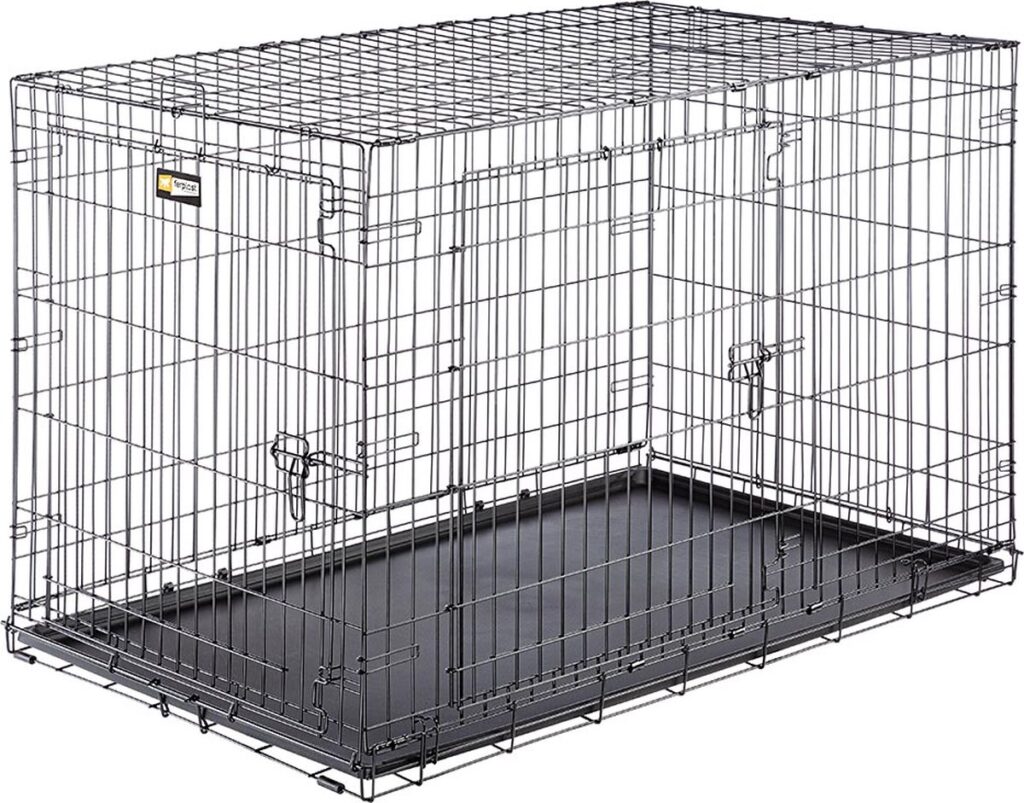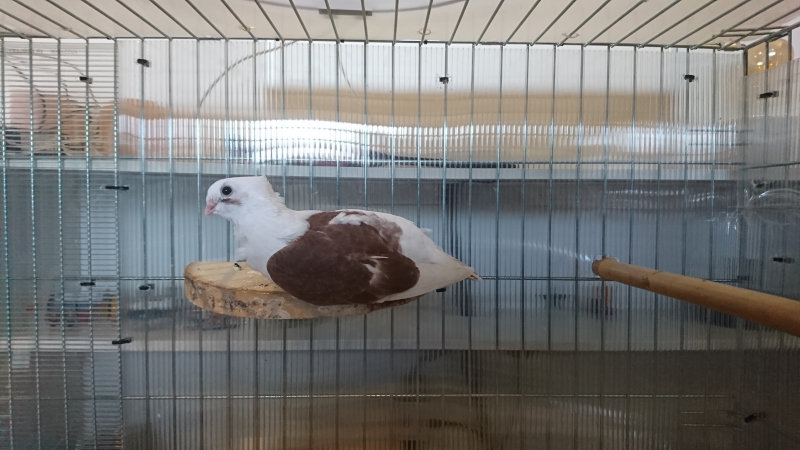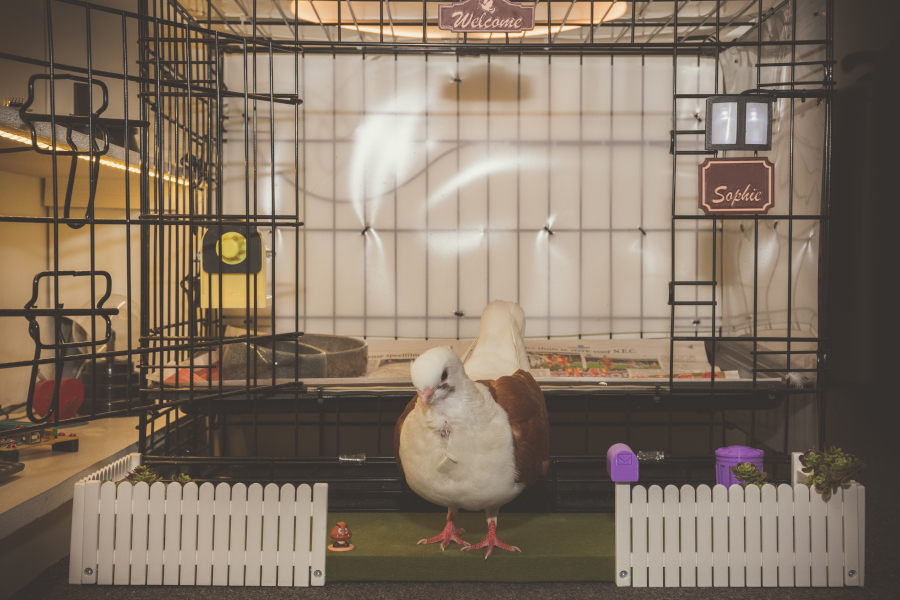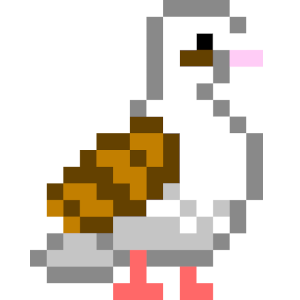reminder: All articles and posts on my website are written by me and from my own perspective (Sophie The Pigeon) and often I'm typing it aimed at other birds 😉
Pigeon & Bird Articles – Housing (cage etc)
This section of my website mainly covers housing of a pet pigeon (or multiple pet pigeons) indoors inside your home. This article is not aimed at people whom are planning to start housing (pet) pigeons in an outdoor aviary or dovecote.
Cage size
Let’s first start with the (required) cage size, obviously bigger is always better I would say. You for example can’t keep a pet pigeon (not even a ‘single pet pigeon’!) in those small ‘standard parakeet cages’. A pet pigeon often needs a (much) bigger cage, most people would however assume that a larger cage would mean a taller cage.
But for pet pigeons the height of the cage is (much) less important than the floor space. We pigeons require (much) more floor (/”walking”) space than height. A parakeet or other type of parrot will often climb around it’s cage utilizing much more of the cage it’s height and such. Pigeons however do not climb the sides of the cages and thus will not use the cage in the same way as a parrot does.
Pigeons need more floor space instead, so that we are able to walk around. Your cage can for example have ‘multiple floors’ (inside the cage) so that we pigeons can choose at what height we want to sit (perch). You can then use ramps so that we can also (more) easily reach those ‘different floor levels’.
Recommended Type of cage
Personally me and my pet humans do not recommend using regular (small) bird cages at all for pigeons, but we instead recommend to use something like a (large) dog bench or a double-flight cage. A double-flight cage is often the better solution but MUCH more expensive than a dog bench, in a dog bench you can for example make ‘additional floors’ (like mentioned before) yourself. If your pigeon is spending most of the day outside of the cage, a dog bench will be more than enough, otherwise at least a double flight cage is recommended.

I myself have two cages, one is my night time cage (also known as my ‘bedroom’) and it is similar to the one shown in this photo. The approximate size of this cage is 125x75x80cm. My pet humans have adapted this cage by adding poly-carbonate channel plates as walls to the back and right side. This doesn’t only make it easier to clean the cage, but it also prevents me from ‘messing up their walls’, it protects me from unwanted drafts and it gives me a bit more a ‘sense of safety’ due to the fact that my “bedroom” isn’t open from all sides.
Next to this my pet humans have also used LCD Diffuse foil (recycled from an old LCD TV) on top of my cage to give it a ‘roof’. On top of this roof they have installed an (LED) lamp on a timer so that my day always starts at a controlled schedule, even If my pet humans themselves are a bit delayed that day (to maintain my normal routine). Inside my bedroom they have installed a wooden perch on which I can sleep or chill (which we call my bed).

In this (older/early days) photo of me, you can see my ‘bed’ which is installed in my bedroom (night time cage) and the poly-carbonate channel plate walls. You also see a ‘stick/round perch’, but you can ignore that one, it has a different purpose which is not needed for regular pigeon cages 🙂
The cage you see here above is the cage I spend the night in, and on very rare occasions (when my humans have to go somewhere where I absolutely can’t come with them) I will also spend (a portion) of the day in this cage.
During the day I have a different (MUCH) smaller cage, and this one is placed in the living room area of my pet humans. This however is neither by me or my pet humans actually considered to be a ‘cage’, but more like “Sophie’s Private Corner“. It kinda is my ‘private living room inside their living room’.
This is the cage which I can use to ‘retreat’ if I would want some ‘private time’, and where I can find my water and food. This cage is basically never closed and will never close (only when I get a timeout because I did VERY bad things, but that only happened twice so far ever 😛 ).

This is my (‘fancy’) home (also known as my daytime cage) where I’m standing in my own personal ‘garden’.
How to choose the correct size of your cage(s)
It is hard to give an ‘hard number’ on required cage size, which is why I yet again would like to point out: “Bigger is better”. But it also depends on how many pigeons you are planning to house in the cage (two pigeons obviously need more space than just one pigeon). Next thing to consider is how much time per day does the pigeon spend inside the cage. If your pigeon only spends the night in it’s cage (like I do), then a cage size like my bedroom’s size is just fine. Even if the pigeon on occasion also needs to spend (a portion of) the day in that cage.
If you are however for example not working from home like one of my pet humans does, and thus can’t let your pigeon(s) out all day long (or most of the day), then it is highly recommended to get a cage with at least three to four times the floor space of my night time cage, and at least twice the height (with multiple floor levels/perches’ installed).
|
Advertisement blocked due to cookie settings.
Please consider reading my AdSense Information page to learn why I use advertisments on my website and how you can enable them. The AdSense Information page also explains that and how I'm telling Google/AdSense to only show non personalized / non tracking advertisements. |
Cage Material & Construction
One very important thing to take into consideration is that the cage does not contain lead, copper and that it is not made out of hot-dipped galvanized zinc! These materials are very poisonous to us birds and should be avoided at all times. More information about this can be found on my Everyday Household Dangers page at the Lead and Zinc (Galvanized steel in cages, food and drink bowls etc) section
Because lots of pet pigeon owners use cages which are officially not intended for pigeons (but for dogs for example), it is also very important that you make sure that we pigeons can’t get stuck in certain parts of the cage (with our claws, head or otherwise), or that we are able to injure ourselves on sharp parts of the cage.
If this is the case, you might be better off looking for a different type or brand of cage, or make sure that you modify it yourself to ‘pigeon proof’ the cage.
Cage Bedding
In my opinion simple old fashioned news paper is the best option for cage bedding for us pigeons. Simply because it’s widely available (and thus easy to obtain), cheap, and does not pose any risk for us pigeons. And because you need to change the bedding every day (for a proper cage hygiene), it won’t be very expensive either if you use news paper as bedding.
I myself even enjoy the ‘variation’ of different ‘floors’ which I have every day, and sometimes I can even be very interested by one of the prints and be playful with it for about 30 minutes or so.
There are also paper bedding sheets available in certain stores which are specifically for this purpose, we however do not know what they cost and where to get them (we only know that they do exist). We much rather just like to use news paper, not because it’s cheap, but because it’s easily available, it is a good way to ‘re-use’ it once more before throwing it away (recycling), and it’s very easy to keep an eye on our droppings when using news paper (more about that later).
TIP: If you don’t have enough news paper yourself, ask one of your neighbors, friends or family members to keep their news papers aside for you. My pet humans only have one family member which keeps their news papers aside for me, and often we even have to ask them to ‘quit saving them’ for a while due to the large amount of news papers they are able to deliver to us. Keep in mind that with one news paper you can already do a single cage for multiple days (at a minimum).
Another very important aspect of using news paper (or any other type of paper bedding), is that it’s much easier to keep an eye on our dropping (poop) as part of our ‘health monitoring routine’. If you use something like sand or any other absorbing bedding, it is much harder to actually see the consistency and/or moisture in our droppings due to the fact that those bedding’s often absorb a lot of it. This generally sounds like an good idea, it however also means that in such bedding’s it is often also a lot easier for parasites, mites and bacteria to live in.
And if you for example would use saw dust or very ‘dusty sand’ as bedding it can also give respiratory issues for us pigeons.
IMPORTANT WARNING
DO NOT use paper sheets which have ‘sand paper effect’ for ‘better grip’! Those sheets will (and can) damage and hurt our feet! And you should not use ‘fluffy’ bedding like towels or so either. This due to the fact that we pigeons might pull off parts (while you humans are not looking or when we are a bit bored), and then this might cause problems when these parts are ingested.
Make sure to also read my other articles about (cage) hygiene, out of cage time and more for optimal care of your pet pigeon(s) 🙂
It is best to keep pigeons in pairs
Pigeons mate for life and really need their/a mate during the day. A human can also be (or become) their ‘mate’ with which they will spend their (entire) day, but this will obviously require quite a lot more attention and dedication to your pigeon. If you aren’t able to be ‘the mate’ of your pigeon, it is highly recommended to get a (bonded) pair so that the pigeon(s) won’t get lonely.
I myself (Sophie The Pigeon) don’t do well with other birds/pigeons, and due to me being a rescue with an history it is (near) impossible to ‘pair me’ with another pigeon now. But because I have bonded (by my own choice!) with one of my pet humans, it is no issue for me, because I’m actually able to be around this human (nearly) the entire day.
We pigeons are very social animals, and really need companionship, so please keep this in mind when considering to get a pet pigeon.
Make sure that you can give us a forever home
Please also make sure that you are absolutely certain that you are able to give your (new) pet pigeon(s) a ‘forever home’. Meaning that they will be able to stay with you for the rest of their live(s). Humans often get pets/animals without realizing how long they can live, or how much ‘time it consumes’ to have a certain pet. Once they then ‘had enough’, those poor animals often end up in animal shelters or even worse: get dumped outside. Please make sure that you do not do this and that you have done more than enough research before actually getting your pet pigeon(s).
